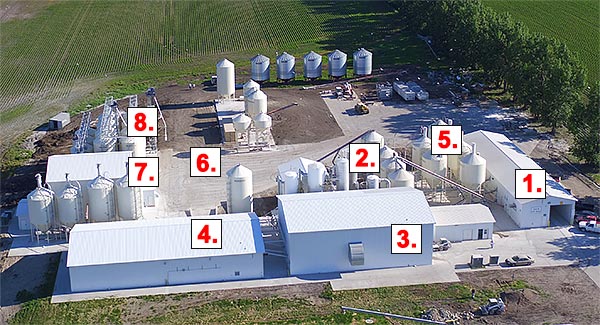-Read More-
-Read Less-


- Receiving for weighing, grading and emptying inbound pea trucks and loading outbound powder trucks. 4,000 bu per hour unloading rate.
- Raw peas sent from receiving area to bin by conveyor– two 3,000 bu raw product bins.
- Cleaning and milling building. Mill capacity of 10,000 pounds per hour. Buhler cleaner and destoner are used to clean peas before they are dried to approx. 11%. Once the peas are split the chips and hulls are sent to a Jacobson hammermill to be processed into fiber.
- Warehouse for toting and tote storage. Six trucks of toted storage capacity.
- Final product bins for bulk truck loadout, powdered product– 3,000 bu capacity per bin.
- 5,000 bu bin loaded by auger from trucks for primarily pelleted product. Product can toted directly from the bin for shipment or to warehouse floor. DDB has separate bins in the mill area for powdered product that is moved to the tote warehouse by screw auger for toting. Most fiber product is loaded into bulk trucks at Lakeview but can also be toted. Pelleted product is shipped in totes, bulk trucks, and bulk hopper cars.
- Lakeview is not on a rail line but utilizes three company-owned semi-trucks to move product 6 miles to Crary. At Crary the pelleted product is loaded into bulk rail cars for shipment throughout the US. Company trucks are used to move chips from Crary to Lakeview to be processed into fractions.
- Final product bins for pelleting, two 5,000 bu bins for starch, two 3,000 bu bins – one for flour and one for protein.
- Final product bins – 13 days of finished pelleted product storage on site.
-Read More-
-Read Less-
 Autorotate
Autorotate Help
Help Maps
Maps Gyro
Gyro Share
Share VR Headset
VR Headset







